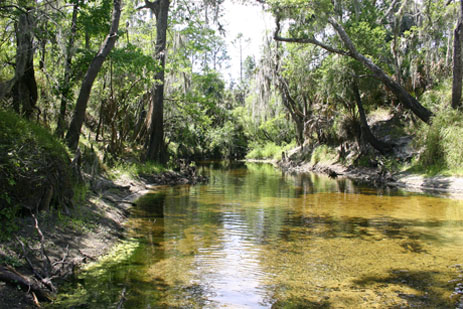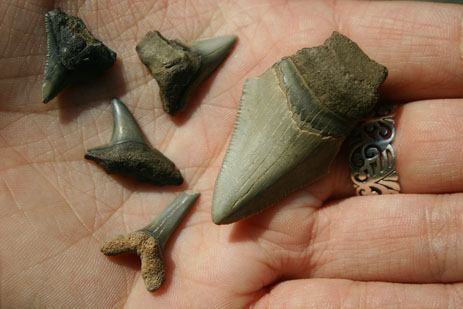 |
|||||||||||
|
|||||||||||
|
Florida is a fossil hunter’s paradise. You don’t need a pick and shovel, just a good eye. Unlike the fossils of the American Northwest, few Florida fossils are encased in rock. They are more likely to be found lying loose on the beach or among the gravel of a small stream. You can hunt for fossils by yourself, or take a professionally guided trip. If you intend to hunt for fossils by yourself, you will need a permit , which cost $5.00. However you don’t need a permit if you want to collect fossilized sharks teeth, shells or plants. The fossilized remains of large mammals such as saber-toothed cats, giant ground sloths, and cave bears are abundant in Florida’s caves, sinkholes and rivers. Page through the 1958 publication Fossil Mammals of Florida (pdf), you will be amazed at the variety of mammals that were walking around in Florida just 100,000 years ago. In the 1950’s and 1960’s it used to be quite common to come across a 2-kg (4.4lb) tooth of an ice age mammoth in the Ichnetucknee or Withlacoochee River. You are much less likely to be that lucky today but one can still find smaller teeth, bones and the occasional whale vertebrae in these and other waterways. Fossil seashells are common on the banks of rivers, and much of the state’s limestone bedrock is made up of the shells of animals that lived in the shallow seas that once covered Florida. Different types of limestone are found in different parts of the state. Limestone in the Florida Keys consists mainly of fossilized corals. Along the east coast, early Floridians quarried great quantities of a limestone rock called ‘coquina.’ The Castillo de San Marcos in St Augustine is built entirely of coquina, and if you look closely at the walls of this fort you can see millions of fossilized sharks teeth. A few miles further south, the beach at Washington Gardens is covered with coquina rocks. Fossil shark teeth are also fairly easy to find in streams and rivers, and enormous numbers of them turn up on the beaches of southwestern Florida. Part of the reason these teeth are so abundant is that sharks shed and replace tens of thousands of teeth in their lifetime – one shark might produce and loose 20,000 teeth in 30 years. Look for them in rivers and creeks especially after a heavy rain. The rainwater carves new deposits from the banks and deposits the fossils on gravel bars and shallow pebbly areas on the creek bed. Look for something dark and shiny, especially in places where the creek bends.  In Gainesville, you can find fossil sharks teeth by sifting through the sand of the small creeks that run through the city. Hogtown Creek and Possum creek are popular sites, especially where they cross 8th Avenue. Look on gravel bars at bends in the creek or in pebbly areas. Jacksonville Beach.
The adventurous can rent scuba gear and dive down to the deposit to get first pick – or, you can snorkel parallel to the shore about ten feet from the edge of the water and look for fossils on the bottom. (Look for small and large black shiny objects, or take a strong colander and sift through the sand). The third option, for non-swimmers, is to simply keep your eyes open while walking on the beach near the waterline. Whether it is scuba or snorkel, diving for fossils and shark teeth in this area is better in spring and early summer when the water is clear. Beach stores sell and rent special ‘Florida snow shovels’ – long handled devices with a basket at the end used to sift fossils from the sand. The most productive time to search is at low tide, or after a big storm. Wade into the water and dredge through anywhere that looks to have dark gravel or pebbles. Blackish lumps are quite likely to be fossilized bones of dugong, whales, tortoise and alligator. Until quite recently small, fossilized shark teeth used to be so common on Venice Beach that you could count on finding them everywhere. However in the 1990’s Venice began a beach renourishment program, and the beaches were fortified with a million cubic yards of sand dredged from offshore, which to some extent covered the original fossil rich sand. Today, teeth can still be found on the beaches, but they are not as plentiful as they once were; most of the real finds are made by people snorkeling or scuba diving just off the beach. Nearby Caspersen Beach, just south of the Venice Municipal Airport is sometimes better than Venice Beach. Depending on the water conditions, snorkeling just off-shore can be quite rewarding. Note: It is rumored that Caspersen Beach is clothing-optional, but the County does not recognize it as a nude beach and clothing is officially required. The Peace River. Note. There are alligators on the Peace River, so stay alert. For this reason it is probably not a good idea to bring a dog along on the trip as dogs tend to look like dinner to alligators. Gardner Bring a screen, something to dig with, and bags to put your finds in. Most people bring a floating sifter – a screen kept afloat by floating ‘noodles’ - and a shovel and simply shovel the gravel into the screen, then pick through the larger pieces left on the screen. Take lunch – once you start its difficult to stop. To get there go south on Highway 17 south of Zolfo springs until you reach the small town of Gardner. Look for a graded dirt road on the right signposted with the boat ramp symbol. Go to the end of the dirt road – quite a way – the boat ramp is at the end. Shell Creek. This link will take you to photos of some of the fossils that have been found on the Peace River. (The maps in the DeLorme Florida Atlas and Gazetteer show boat ramps and canoe access points in great detail.)
|
| • Live weather radar • About Florida weather • Map & Key to Regions |

Wildlife of Florida 2011
Fiona Sunquist
Download $19.99


Wildlife of Florida: Lizards
Fiona Sunquist
Download $2.49

gator/crocs | birds | mammals | snakes | turtles | frogs/toads | lizards | sharks
Wildlife | Favorite Activities | My Destinations | about us | resources | site map | home
![]() web site development by Creative Communications
web site development by Creative Communications













